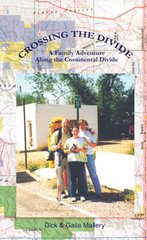
By SCOTT McMILLION
Jim Horan saw a startling thing. Rounding a corner on a trail in Glacier National Park, he saw a vision: a Guinness beer standing in the middle of a bridge, all by itself.
“It stopped me in my tracks,” he said. “Like seeing a grizzly bear.”
Horan's thirst is understandable. He was on the last leg of a 2,500 mile, five-month hike from the Mexican border to the Canadian border, all of it along the Continental Divide.
His adventure was coming to an end and he'd been having reveries involving good beer and the Lazy Boy recliner in his Livingston home. And then one of those dreams came true, courtesy of his friend Norman Miller, who'd placed the beer on the bridge and hidden himself, waiting to see Horan's reaction.
Miller had more beers with him and when he emerged from hiding, the friends had a laugh and drank them all, celebrating on the trail.
Horan had a lot to celebrate. Hiking the Continental Divide Trail is an incredible undertaking, one attempted by many and accomplished by few.
The route led him through alpine blizzards, incredible thunderstorms, sparse deserts and more than a few dicey crossings of busy highways.
“Sometimes, the most dangerous part of the hike was getting across roads -- trying to run across four lanes of traffic when everyone's trying to pass each other,” Horan said.
There were other adventures.
One time, postholing through deep snow on a high ridge in Colorado, the kind of hike where you need an ice axe, a storm blew through with winds strong enough to knock him down.
Later, along the Montana-Idaho border, fierce lightning came down so fast and frequent he could have read a book in the near-constant glow. So Horan and his companions skedaddled down into some timber.
“But the wind was blowing over trees all around us,” he said.
So they hunkered down and suffered out the storm, which was their only option.
For most of the hike, Horan traveled with a friend, Colorado resident Mark Dixon. But Dixon had to return to his U.S. Forest Service job before the trip was complete, so Horan, a book distributor, soloed the final miles through the Bob Marshall Wilderness and Glacier Park, where grizzly bears left steaming reminders of their presence along the brush-choked trails.
And then there was the drudgery. The trail is a national scenic trail, designated as such in 1978 by the federal government. But about a third of it remains “undesignated,” said trail administrator Greg Warren. That means hikers must rely on their own devices to plan routes.
“Lots of it is unmarked,” Horan said, although maps can be downloaded from the Internet and overlaid with Forest Service maps.
No routes stick to the divide every foot of the way. But all of them require you to cross it dozens of times.
Just preparing for the hike is a lot of work. The two men bought, loaded and shipped 35 boxes of food to post offices along the route. They had to arrange for long absences from home and work. And they had to keep themselves motivated to keep moving.
“It's not just the physical skills,” said Josh Shusko, spokesman for the Continental Divide Trail Alliance, a Colorado-based group. “You also need navigational skills and the mental attitude.”
Horan said he and Dixon were on the trail most mornings by 7:15 a.m. and generally covered 20 to 25 miles a day, slowing only when laid up by illness or injury, which came in the form of shin splints, intestinal distress and blisters. Only about once a month did they take a full day off.
Although he ate steadily - lots of noodles, pop tarts, sausage, tortillas and tuna, and all the beer and ice cream he could find - Horan said he was hungry all the time and lost about 25 pounds from his 191 pound frame,.
Hardships came, but so did pleasures, in the form of seeing new country under his own steam, arriving at previously hidden caches of tequila and beer, and meeting new people, both on the trail and in the small towns they hiked into every few days.
While hiking across the Great Divide Basin near Rawlins, Wyo., Horan and Dixon met a particularly friendly couple traveling the area in a van. Every night, the couple showed up at a prearranged campsite with cold drinks, watermelon and a sunshade in that parched and empty section of the Cowboy State.
“It was like it was catered,” Horan said. “We loved it.”
The occasional town usually meant a hot shower, a place to do laundry and restaurants to break the food monotony.
Ironically, when Horan checked into motels every few days, he often found himself unable to sleep well. After weeks on the trail, the town noises were too distracting and he found himself eager to go.
“We were always jonesing to get back on the trail,” he said.
Horan is no stranger to mega hikes. He hiked 650 miles spanning Arizona from south to north, including part of the Grand Canyon, and took on the East Coast Trail in Newfoundland, in the sodden month of November.
The Canadians thought he was a little kooky, he said.
In 1998, he and Dixon completed the 2,650-mile Pacific Crest Trail, tracing a different route from the Mexican border to Canada. And he's got his eye on the 2,175-mile Appalachian Trail, which would make him one of only a few dozen people to complete the “Triple Crown” of distance hiking.
“I'm 45,” he said. “There's time.”
“It stopped me in my tracks,” he said. “Like seeing a grizzly bear.”
Horan's thirst is understandable. He was on the last leg of a 2,500 mile, five-month hike from the Mexican border to the Canadian border, all of it along the Continental Divide.
His adventure was coming to an end and he'd been having reveries involving good beer and the Lazy Boy recliner in his Livingston home. And then one of those dreams came true, courtesy of his friend Norman Miller, who'd placed the beer on the bridge and hidden himself, waiting to see Horan's reaction.
Miller had more beers with him and when he emerged from hiding, the friends had a laugh and drank them all, celebrating on the trail.
Horan had a lot to celebrate. Hiking the Continental Divide Trail is an incredible undertaking, one attempted by many and accomplished by few.
The route led him through alpine blizzards, incredible thunderstorms, sparse deserts and more than a few dicey crossings of busy highways.
“Sometimes, the most dangerous part of the hike was getting across roads -- trying to run across four lanes of traffic when everyone's trying to pass each other,” Horan said.
There were other adventures.
One time, postholing through deep snow on a high ridge in Colorado, the kind of hike where you need an ice axe, a storm blew through with winds strong enough to knock him down.
Later, along the Montana-Idaho border, fierce lightning came down so fast and frequent he could have read a book in the near-constant glow. So Horan and his companions skedaddled down into some timber.
“But the wind was blowing over trees all around us,” he said.
So they hunkered down and suffered out the storm, which was their only option.
For most of the hike, Horan traveled with a friend, Colorado resident Mark Dixon. But Dixon had to return to his U.S. Forest Service job before the trip was complete, so Horan, a book distributor, soloed the final miles through the Bob Marshall Wilderness and Glacier Park, where grizzly bears left steaming reminders of their presence along the brush-choked trails.
And then there was the drudgery. The trail is a national scenic trail, designated as such in 1978 by the federal government. But about a third of it remains “undesignated,” said trail administrator Greg Warren. That means hikers must rely on their own devices to plan routes.
“Lots of it is unmarked,” Horan said, although maps can be downloaded from the Internet and overlaid with Forest Service maps.
No routes stick to the divide every foot of the way. But all of them require you to cross it dozens of times.
Just preparing for the hike is a lot of work. The two men bought, loaded and shipped 35 boxes of food to post offices along the route. They had to arrange for long absences from home and work. And they had to keep themselves motivated to keep moving.
“It's not just the physical skills,” said Josh Shusko, spokesman for the Continental Divide Trail Alliance, a Colorado-based group. “You also need navigational skills and the mental attitude.”
Horan said he and Dixon were on the trail most mornings by 7:15 a.m. and generally covered 20 to 25 miles a day, slowing only when laid up by illness or injury, which came in the form of shin splints, intestinal distress and blisters. Only about once a month did they take a full day off.
Although he ate steadily - lots of noodles, pop tarts, sausage, tortillas and tuna, and all the beer and ice cream he could find - Horan said he was hungry all the time and lost about 25 pounds from his 191 pound frame,.
Hardships came, but so did pleasures, in the form of seeing new country under his own steam, arriving at previously hidden caches of tequila and beer, and meeting new people, both on the trail and in the small towns they hiked into every few days.
While hiking across the Great Divide Basin near Rawlins, Wyo., Horan and Dixon met a particularly friendly couple traveling the area in a van. Every night, the couple showed up at a prearranged campsite with cold drinks, watermelon and a sunshade in that parched and empty section of the Cowboy State.
“It was like it was catered,” Horan said. “We loved it.”
The occasional town usually meant a hot shower, a place to do laundry and restaurants to break the food monotony.
Ironically, when Horan checked into motels every few days, he often found himself unable to sleep well. After weeks on the trail, the town noises were too distracting and he found himself eager to go.
“We were always jonesing to get back on the trail,” he said.
Horan is no stranger to mega hikes. He hiked 650 miles spanning Arizona from south to north, including part of the Grand Canyon, and took on the East Coast Trail in Newfoundland, in the sodden month of November.
The Canadians thought he was a little kooky, he said.
In 1998, he and Dixon completed the 2,650-mile Pacific Crest Trail, tracing a different route from the Mexican border to Canada. And he's got his eye on the 2,175-mile Appalachian Trail, which would make him one of only a few dozen people to complete the “Triple Crown” of distance hiking.
“I'm 45,” he said. “There's time.”












No comments:
Post a Comment